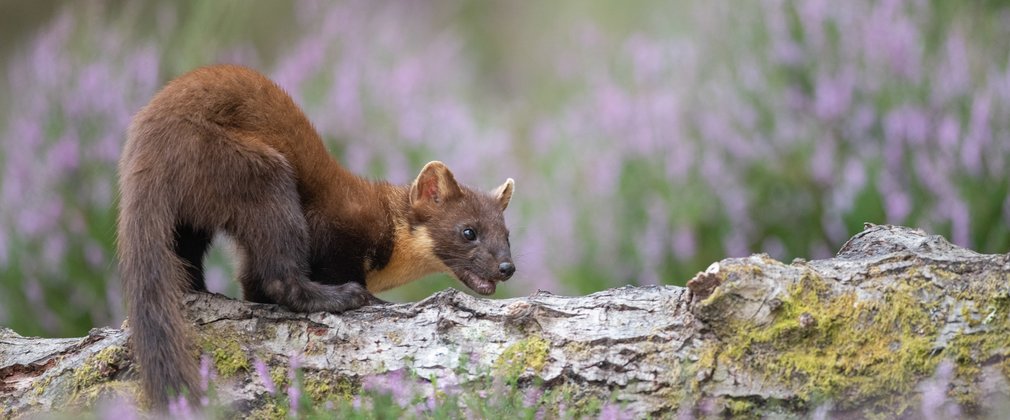
Pine marten population continues to expand in the south of England
3 January 2024
After being absent for decades, pine martens are now present across the New Forest and successfully breeding here according to the results of a three-year study into these rare creatures. Conservationists placed 30 hidden cameras in 11 different parts of the New Forest to observe how these protected creatures are returning to the area.
Pine martens, a cat-sized member of the weasel family, were once widespread across the UK before habitat loss and persecution left only small and fragmented populations, mostly in northern England, Scotland, and parts of Wales.
The study began after a number of reports of public sightings suggested pine martens may have returned to the New Forest. Led by Forestry England and Wild New Forest, with support from Hampshire & Isle of Wight Wildlife Trust, it aims to understand how these rare creatures are settling here and the size of the population.
A range of techniques were used to study these nocturnal creatures, including hidden cameras and thermal imaging surveys. By analysing over 1,000 hours of footage, the team have been able to confirm that pine martens are not only present but that they have settled right across the New Forest. The network of ancient woodlands here is providing an ideal habitat for them to nest, breed and establish territories. The veteran trees in these areas provide good nesting sites in cavities and plenty of food is available for this omnivorous mammal.
Video clips captured in 2023 clearly show the presence of kits and young pine martens that help to confirm breeding is taking place. The cameras used this year also recorded the presence of other key species of wildlife in the Forest including pole cats, another rare but returning creature.
Leanne Sargeant, Senior Ecologist for Forestry England, said:
“We are absolutely delighted to confirm that pine martens have returned to the New Forest and can be found in so many areas. The nation’s forests provide such important areas for wildlife to thrive and expand and the New Forest is doing just that for these special creatures. Now we know they are here and breeding, our next step is to try and estimate the size the population and how they are using the New Forests ancient woodlands.”
Over the next few years, the team hope to combine the video with other methods including DNA analysis to assess the size of the population of pine martens in the New Forest. Mostly chestnut brown in colour, each pine marten has a uniquely shaped bib – a pale yellow section of fur on its chin and throat. This can help to identify individuals and, by observing their interactions, the team may also be able to monitor family groups.
Marcus Ward from the specialist conservation consultancy, Wild New Forest, said:
“Pine Martens are incredibly rare and very difficult to spot, making it difficult to study them. The footage collected by the cameras has given us a really unique view into their hidden world and will really help advance our understanding of these special creatures and how best to support them.”
The project will share its findings with the national pine marten strategy focussing on wider recovery of the species. The survey team are also being supported by the New Forest Badger Group and are keen for other organisations and landowners to get involved in the project.
Forestry England is helping to return lost species of wildlife as a key part of nature recovery across the nation’s forests. It is supporting a range of projects to help secure the return of pine martens and monitoring populations in the New Forest, Kielder Forest, Grizedale Forest and in the Forest of Dean, where England’s first reintroduction of pine martens began in 2019.
Notes to Editor
- Forestry England manages and cares for the nation’s 1,500 woods and forests, with over 291 million visits in 2022/23. As England’s largest land manager, we shape landscapes and enhance forests for people to enjoy, wildlife to flourish and businesses to grow. We are continuing the work we have already started to make the nation’s forests resilient to climate change and by 2026 we will:
- create at least 6,000 more hectares where we integrate wilding activities in our productive forests.
- increase the diversity of visitors to the nation’s forests and have one million hours of high-quality volunteer time given to the nation’s forests.
- plant at least 2,000 hectares of new, high quality, predominantly broadleaf woodlands.
- For more information visit www.forestryengland.uk
- Forestry England is an agency of the Forestry Commission.
- About Wild New Forest
Wild New Forest is a not-for-profit community interest company established in 2016 with the primary aim of supporting wildlife conservation action in the New Forest National Park, through field-based recording and survey work. Our secondary aim is to responsibly share information about New Forest wildlife, in order to assist and inspire others to discover and protect this special place.
Wild New Forest generates fund via a series of guided wildlife walks and boat trips across the New Forest looking at the specialist fauna, flora and fungi while also discussing the habitats, management and history of the New Forest.
Further info can be found on our website at www.wildnewforest.co.uk
Media Contact:
Susan Smith, Media Officer, South Forest District, Forestry England
